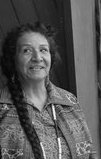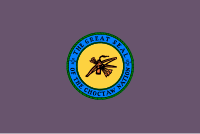
The Choctaw are a Native American people originally based in the Southeastern Woodlands, in what is now Alabama and Mississippi. Their Choctaw language is a Western Muskogean language. Today, Choctaw people are enrolled in three federally recognized tribes: the Choctaw Nation of Oklahoma, Mississippi Band of Choctaw Indians, and Jena Band of Choctaw Indians in Louisiana.

The Choctaw Nation of Oklahoma is a Native American reservation occupying portions of southeastern Oklahoma in the United States. At roughly 6,952,960 acres, it is the second-largest reservation in area after the Navajo, exceeding that of eight U.S. states. The seat of government is located in Durant, Oklahoma.
The Mississippi Band of Choctaw Indians is one of three federally recognized tribes of Choctaw people, and the only one in the state of Mississippi. On April 20, 1945, this tribe organized under the Indian Reorganization Act of 1934. Their reservation included lands in Neshoba, Leake, Newton, Scott, Jones, Attala, Kemper, and Winston counties. The Mississippi Choctaw regained stewardship of their mother mound, Nanih Waiya mounds and cave in 2008. The Mississippi Band of Choctaw have declared August 18 as a tribal holiday to celebrate their regaining control of the sacred site. The other two Choctaw groups are the Choctaw Nation of Oklahoma, the third largest tribe in the United States, and the Jena Band of Choctaw Indians, located in Louisiana.

The Chickasaw Nation is a federally recognized Native American tribe with headquarters in Ada, Oklahoma, in the United States. They are an Indigenous people of the Southeastern Woodlands, originally from northern Mississippi, northwestern Alabama, southwestern Kentucky, and western Tennessee. Today, the Chickasaw Nation is the 13th largest tribe in the United States.

The history of Oklahoma refers to the history of the state of Oklahoma and the land that the state now occupies. Areas of Oklahoma east of its panhandle were acquired in the Louisiana Purchase of 1803, while the Panhandle was not acquired until the U.S. land acquisitions following the Mexican–American War (1846–1848).

The Red Power movement was a social movement led by Native American youth to demand self-determination for Native Americans in the United States. Organizations that were part of the Red Power Movement include the American Indian Movement (AIM) and the National Indian Youth Council (NIYC). This movement sought the rights for Native Americans to make policies and programs for themselves while maintaining and controlling their own land and resources. The Red Power movement took a confrontational and civil disobedience approach to inciting change in United States to Native American affairs compared to using negotiations and settlements, which national Native American groups such as National Congress of American Indians had before. Red Power centered around mass action, militant action, and unified action.
Indian termination is a phrase describing United States policies relating to Native Americans from the mid-1940s to the mid-1960s. It was shaped by a series of laws and practices with the intent of assimilating Native Americans into mainstream American society. Cultural assimilation of Native Americans was not new; the belief that indigenous people should abandon their traditional lives and become what the government considers "civilized" had been the basis of policy for centuries. What was new, however, was the sense of urgency that, with or without consent, tribes must be terminated and begin to live "as Americans." To that end, Congress set about ending the special relationship between tribes and the federal government.

The National Congress of American Indians (NCAI) is an American Indian and Alaska Native rights organization. It was founded in 1944 to represent the tribes and resist U.S. federal government pressure for termination of tribal rights and assimilation of their people. These were in contradiction of their treaty rights and status as sovereign entities. The organization continues to be an association of federally recognized and state-recognized Indian tribes.
Native American self-determination refers to the social movements, legislation and beliefs by which the Native American tribes in the United States exercise self-governance and decision-making on issues that affect their own people.

The Indian Self-Determination and Education Assistance Act of 1975 authorized the Secretary of the Interior, the Secretary of Health, Education, and Welfare, and some other government agencies to enter into contracts with, and make grants directly to, federally recognized Indian tribes. The tribes would have authority for how they administered the funds, which gave them greater control over their welfare. The ISDEAA is codified at Title 25, United States Code, beginning at section 5301.

Lucy Friedlander Covington was a Native American tribal leader and political activist. She was a member of the Colville tribe which has a reservation in north-eastern Washington state. Covington was the granddaughter of the last Colville chief to be acknowledged by the tribe. She was the daughter of Nellie Moses and Louis T. Friedlander Sr.
Clyde Merton Warrior (1939–1968) was a Native American activist and leader, orator and one of the founders of the National Indian Youth Council. He participated in the March on Washington and the War on Poverty in the 1960s and was a charismatic speaker on Indian self-determination.
Pan-Indianism is a philosophical and political approach promoting unity, and to some extent cultural homogenization, among different Indigenous groups in the Americas regardless of tribal distinctions and cultural differences.
The following outline is provided as an overview of and topical guide to United States federal Indian law and policy:
Hollis E. Roberts was a Native American politician whose career was highlighted by his 19-year period as Chief of the Choctaw Nation. His reign saw the tribe modernize its social services and develop independent business partnerships in and beyond Oklahoma.

Harry James Watson "Jimmy" Belvin was a Native American educator who served as an Oklahoma State Representative and Senator. He was the first elected principal chief of any of the Five Civilized Tribes in the 20th century, and the longest serving principal chief of the Choctaw Nation of Oklahoma. He saw his tribe through termination, restoration, and a rebirth of Native Pride. He was a polarizing leader, seen by some as a semi-dictator who held onto the office of principal chief and used his power to advocate for complete assimilation into the dominant society, suppressing Choctaw traditions, language and ceremonial practices as undesirable remnants of an unrefined history. To others, he was a well-liked, populist leader, who went door-to-door talking with tribe members, informing them on issues, and trying to develop the means the alleviate the poverty and unemployment they faced.
Viola Hatch was a Native American activist, founding member of the National Indian Youth Council, and former Tribal Chair of the Cheyenne and Arapaho Tribes. She successfully sued the Canton, Oklahoma schools regarding the right of students to obtain an education.
Clara Sue Kidwell is a Native American academic scholar, historian, feminist and Native American author. She is enrolled in the Choctaw Nation of Oklahoma and of White Earth Ojibwe descent. She is considered to be a "major figure in the development of American Indian Studies programs."
James Lawrence McDonald (c. 1801 — September 1831), was a member of the American Indian tribe called the Choctaw and the first Native leader of his generation to be trained in the American legal system. Thus, he is known as the first Native American lawyer. He was also the first Native activist to make the case for Indian rights directly to American political leaders and to negotiate for those rights in a formal agreement. McDonald did not believe in the use of force in resisting American westward expansion. Instead, he believed that political negotiations between Native American leaders and the United States would be more effective in the fight against the displacement of Natives and would allow for the long-term survival of Native American communities. McDonald urged the U.S. Congress to protect the rights of Native Americans and delayed the removal of his tribe from ancestral lands. As an advisor to Choctaw chiefs and eventual lawyer of the tribe, McDonald successfully negotiated peace treaties with the United States federal government. These negotiations allowed fair compensation for previously ceded land that was undervalued in earlier agreements. He also promoted programs of Indian education and wrote on behalf of the elected tribal governments. McDonald’s work as a lawyer and political activist paved a new path in which future Native American leaders were able to defend the rights of their territory using the American legal system. His career marked the birth of a new approach to federal power, and by extension, the beginning of political activism that was to inspire tribal leaders across the continent.
The History of the Choctaws, or Chahtas, are a Native American people originally from the Southeast of what is currently known as the United States. They are known for their rapid post-colonial adoption of a written language, transitioning to yeoman farming methods, having European-American lifestyles enforced in their society, and acquiring some customs from Africans they enslaved.










